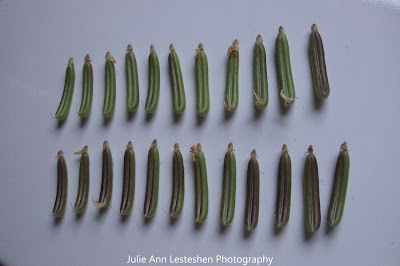Crotalaria Mucronata? What's that you say? Yes, I am thinking, what the heck? I have been growing a mystery green plant in one of my large flower pots out front. Today, I was able to confidently identify the mystery plant as Crotalaria Mucronata aka Crotalaria Pallida.
 |
| Crotalaria Mucronata - March 3, 2019 |
In the March 3rd photo, I noticed the seed pods at the bottom of the very long flowery projectile. At first, there were tiny little yellow flowers along the projectile. In mid February, the flowery projectile was a solid twelve inches in growth and grew to a length of about twenty-four inches!!
Below is a series of photographs of the plant's growth over the course of about one month from January 31st through February 26th.
 |
| Crotalaria Mucronata - February 26, 2019 |
 |
| Crotalaria Mucronata - February 19, 2019 |
 |
| Crotalaria Mucronata - February 12, 2019 |
 |
| Crotalaria Mucronata - January 31, 2019 |
I can readily admit that, at first, I thought this might be a poison ivy plant because of the trifoliate leaves. I reached out to the Lake County Extension Office three times for an identification, asking if this might be poison ivy -- I never received any response from them.
After asking my friends on Facebook, I was able to eliminate poison ivy and at least get into the right family! Once the flowery projectile emerged, a friend of mine, Chloe from England, identified the plant family of
Fabaceae. She was right!
"The Fabaceae or Leguminosae, commonly known as the legume, pea, or bean family, are a large and economically important family of flowering plants."
INTERESTING SEED PODS<
 |
| Crotalaria Mucronata 23 Seed Pods - March 4, 2019 |
 |
| Crotalaria Mucronata 23 Seed Pods - March 4, 2019 |
 |
| Crotalaria Mucronata Opened Seed Pod - March 4, 2019 |
It was the cylindrical seed pod, with the crease or suture down the middle, that snagged the true identification of this mystery plant! Within the hour after I posted the seed pods on my Facebook page, I was searching Google for images of the seed pod. Quite by accident, I stumbled upon an image with a copyright of Horace Tan ... that nailed the ID for me as there was NO doubt this was the same type of seed pod. I followed that image of Horace Tan to a
page of other photographs of the Crotalaria Mucronata.
In a blog post from "Butterflies of Singapore" entitled
Life History of the Pea Blue, the Crotalaria Mucronata is showcased as the host plant for the Pea Blue Butterfly. Be sure to take a look at that blog post for some excellent photography by Horace Tan and interesting information about the life cycle of the Pea Blue!
Researching to learn more about this interesting plant, I found the
Wikipedia reference on Crotalaria. It states that
"Crotalaria is a genus of flowering plants in the legume family Fabaceae (subfamily Faboideae) commonly known as rattlepods."
Crotalaria Mucronata is a synonym for
Crotalaria Pallida and is
"commonly known as the chique chique, gergellim bravo, giant striata, guizo-de-cascavel, maraca-de-cobra, rattleweed, rattlebox, smooth crotalaria, or the streaked rattlepod." There are some 700 species of Crotalaria!
What's interesting is it
"was reported to be widely used in the southern part of the U.S.A. as a green manure crop under the name 'giant striata.'" It also has a number of beneficial uses where the flowers are eaten as a vegetable, the seeds are ground and roasted as a coffee beverage, the roots are chewed with betel nuts, the plant is used to treat urinary problems and fever, the roots help with joint swelling, and the leaves extract helps to repel intestinal worms! Wow, that is some plant ... and pretty crazy now to think I thought it was poison ivy!!
UPDATE: My Crotalaria Mucronata aka Crotalaria Pallida has been really progressing on its growth. The flowery projectiles have emerged with yellow flowers from each of the greenery ends. My photos don't seem to capture how impressive this plant has become ... I think I will need to move it to another location that is more photographic.
 |
| Crotalaria Mucronata aka Crotalaria Pallida - March 11, 2019 |
MORE SEED PODS
The afternoon of March 14th, I noticed two of the many flowery projections had seed pods that had recently emerged. Instead of removing these as I did the seed pods from the middle long flowery projection, we are going to watch to see how these age and how they open to reveal and release the seeds.
 |
| Crotalaria Mucronata Seed Pods - March 14, 2019 |
 |
| Crotalaria Mucronata Seed Pods - March 14, 2019 |
OH NO!
It was a bit past mid-March, 2019 when I attempted to relocate the Crotalaria Mucronata from the black planter. I found that the roots had become imbedded deep in the pot, into the river pebbles that I had for drainage. I did my best to replant it in a good spot, with potting mix, in the front yard garden. However, the evening after I moved it, all the paper-thin leaves were droopy. The plant began to look like a weed! I was heartbroken to see curiosity of a plant go bye-bye!










